Favorable weather conditions between 19 August and 5 September 2017 enabled the CAMS BeNeLux network to collect 3189 orbits. A radiant concentration was spotted which was identified as the August gamma Cepheids (523-AGC). An independent search on a selection from all available meteor orbit lists coming from the suspect radiant area and velocity range was made. This resulted in 283 similar orbits, radiating from R.A. 358.4° and Decl. +76.2° with a geocentric velocity of 43.7 km/s in a time lapse between 146° and 165° in solar longitude with best activity at ~155.7°. The orbital elements match perfectly with previously published results. There is no indication for any periodicity in the shower displays from year to year. The AGC-meteors are remarkably rich in bright meteors and rather deficient in faint meteors. Being detected independently from orbital data collected by different video networks, confirmed by 283 orbits with a medium threshold D criterion DD < 0.08 and 125 orbits with a high threshold of DD < 0.04, this minor shower could be considered to be listed as an established meteor shower.
1 Introduction
The month of August is one of the richest meteor months of the year, not only due to the annual Perseid display but mainly because of the combined activity of many different meteor showers. All these different sources add activity onto the sporadic background, with different activity profiles and variable maxima. The complex mixture of shower and non-shower origin of the total hourly rates makes it impossible to determine the actual diurnal sporadic background activity. Except for the major contribution from the Perseid, the Aquariid and Capricornid radiants, the many different sources that contribute to this rich but complex activity are poorly known. For most of the minor shower radiants single station meteor observations will fail to identify the shower membership in a statistical relevant way. Triangulation and accurate velocity determination are required to determine the individual meteor orbits. These orbits can help to detect similarity between orbits and resolve the complex mixture of many different sources, their activity period, activity profile and other characteristics.
One of these minor showers, the ‘August gamma Cepheids (523 AGC)’, caught the attention of the BeNeLux CAMS network operator (Johannink, 2017). This relative recently discovered minor stream is an interesting case study to check what we can find in the datasets of the main video camera networks.
2 CAMS BeNeLux and the AGC-523
The BeNeLux CAMS network collected 3189 orbits between 19 August and 5 September 2017. Only two nights suffered poor weather circumstances and had less orbits. A stream search for the AGC-523 was applied, using the previously determined orbit of CAMS as parent orbit with the DD criterion of Drummond (1981). This resulted in 66 orbits that fulfilled DD < 0.105. Using a stronger criterion with DD < 0.06 still resulted in 25 candidate orbits for this shower. These orbits are listed in Table 2. No sign of any radiant drift could be noticed.
3 AGC (523) history
An effort to locate any earlier records of this meteor shower remained negative. The photographic meteor orbit catalogue with 4873 accurate photographic orbits contains only one possible AGC orbit (DD < 0.02) recorded in 1979. The Harvard radar orbit catalogues 1961–1965 and 1968–1969 contain only two orbits with DD < 0.08, one in 1962 and one in 1963. One photographic and two radar orbits do not make yet a meteor shower; hence we do not have any positive confirmation from past observations.
This minor shower was first noticed in a stream search on CMN (Croatian Meteor Network) and SonotaCo (Japan) orbit data 2007–2012 (Andreić et al., 2013). 44 similar orbits were associated with this stream between 21 August and 4 September with a maximum at 28 August. The radiant appeared to be very diffuse; the data is listed in Table 2.
Dr. Peter Jenniskens confirmed the ACG meteor shower with 15 orbits recorded in 2011–2012 (Jenniskens et al., 2016).
4 Available data end 2017
Since the current knowledge of this minor shower is based upon the available orbit data until 2012, 5 years ago, the author decided to run a search on the combined data for the major video camera networks. We have the following data, status as of end 2017, available for our search:
- EDMOND 05v03 with 252425 orbits (until 2015). EDMOND collects data from different European networks (Kornos et al., 2014).
- SonotaCo with 231024 orbits (2007–2016). SonotaCo is an amateur video network with over 100 cameras in Japan (SonotaCo, 2009).
- CMN with 39991 orbits (2007–2013). The Croatian Meteor Network is operated by amateurs with about 20 cameras (Šegon et al., 2012).
- CAMS with 111233 orbits (October 2010 – March 2013), (Jenniskens et al., 2011). For clarity, the CAMS BeNeLux orbits 2013–2017 are not included in this dataset.
5 Preliminary orbit selection
A preselection is made in order to limit the number of orbits to be analyzed. The selection criteria should be chosen carefully to cover the possible activity period as well as the dispersion that characterizes diffuse minor meteor showers. Taking the known parameters from Andreić et al. (2013) and Jenniskens et al. (2016), a dataset is extracted from the available orbit catalogues. If a cluster of similar orbits occurs in the selection, this should be detected by the D-criteria. The approach has been explained in a previous case study (Roggemans and Johannink, 2018). The author uses three slightly different criteria and consider an orbit similar when all three criteria are fulfilled. The three criteria used are DSH, or Southworth and Hawkins (1963), DD, Drummond (1981) and DH, Jopek (1993). To avoid any bias the preselection is defined with sufficient margins relative to the known parameters. The existing orbital parameters are currently used to identify shower members for CAMS (see Figure 1).
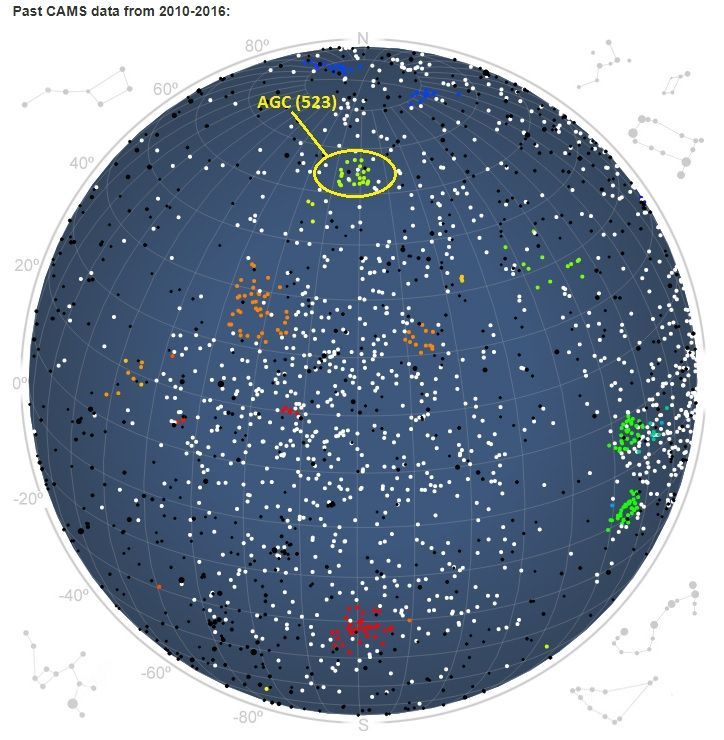
Figure 1 – Radiant map for August 28 based on 2010–2016 data of CAMS. The AGC (523) radiants are the green dots marked on the map.
The activity period was known to start on 21 August (λʘ = 148°) and to end about 4 September (λʘ = 161°). In order to include possible earlier or later orbits, a first selection covered a timespan 140° < λʘ < 172°. The radiant was reported to be diffuse without any trace of radiant drift, the high declination results in a large spread in Right Ascension. The radiant area was chosen as
340° < α < 15° and +72° < δ < +82° with a geocentric velocity interval of 41 to 47 km/s. A total of 343 orbits fulfilled these conditions.
A first parent orbit was approached as the median values of the orbital elements of these 343 orbits obtained in this time span from the suspected radiant area and geocentric velocity interval. The resulting parent orbit proved remarkably similar to the known orbit for the August γ Cepheids (AGC-523). Applying the D-criteria with
DSH < 0.2, DD < 0.08 and DH < 0.2 resulted in 237 orbits, with median values that compare perfectly with the previously published values. 122 orbits fulfilled the
D-criteria set with a high threshold DSH < 0.1, DD < 0.04 and DH < 0.12. The first 6 and the last 6 days of the selected time span produced not any single possible AGC orbit, while the radiant area seemed to be taken too small.
Based on this first approach, a second selection was made, limiting the time span to 146° < λʘ < 166° in order to reduce the contamination of the sample with sporadic orbits beyond the activity period. On the other hand a larger radiant area was set as 330° < α < 25° and +68° < δ < +86° with 41 km/s < vg < 47 km/s. A total of 485 orbits matched these conditions as suspect sample.
The median values of these 485 orbits were used as parent orbit for a first test with the D-criteria set as DSH < 0.2, DD < 0.08 and DH < 0.2 and resulted in 290 orbits within these similarity limits. 125 orbits fitted within DSH < 0.1, DD < 0.04 and DH < 0.1. Taking the median values of the orbits that fit the high threshold condition as new parent orbit, 283 orbits prove to respect the D-criteria with DSH < 0.2, DD < 0.08 and DH < 0.2. The presence of a cluster of similar orbits is very obvious in the selected dataset as the median values for the orbital elements at each step differ only by very small amounts in the decimals.
The author reminds that the D-criteria allow finding similarity between different orbits. Similar orbits have a high probability to represent meteoroids of a same meteor stream, but it does not prove a common origin. In theory similar orbits can occur without any physical relationship. On the other hand some orbits that fail to respect the D-criteria may be real shower members. Meteoroids in meteor streams get perturbed during their lifetime, spreading on dispersed orbits until no similarity can be detected. Although triangulation is the most accurate method to determine the actual radiant position, velocity and orbit, measuring errors or unfavorable geometric configurations result in significant error margins on the final results, especially the velocity determination is very sensitive to errors in the registration technique.
6 Case study AGC-523: results
The final sample of 283 probable AGC-523 orbits includes 20 CAMS orbits (from 31), 19 CMN orbits (from 33), 175 EDMOND orbits (from 308) and 69 SonotaCo orbits (from 113).
The 485 preselected orbits fulfill all criteria which a single station visual or video observer has to identify shower membership. Only 58% of these orbits qualified as probable AGC-523 members with semi-strict D-criteria and only 26% fit the high threshold D-criteria. The high contamination of the sample with sporadic meteors raises questions as to which extend single station video work can be used in a statistical reliable way.
Plotting the inclination i against the length of perihelion Π shows the outliers marked with black dots, these orbits differ too much from the parent orbit to fit any similarity criteria. The orbits that fulfill the D-criteria appear as a nice cluster (green dots) with a core of orbits that fit the high threshold criteria (red dots) (Figure 2).
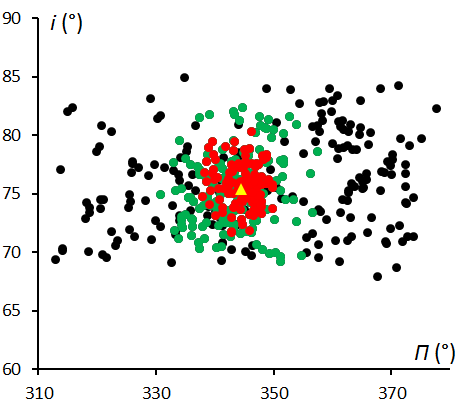
Figure 2 – A plot of the inclination i against the length of perihelion Π for the 485 preselected orbits which have a radiant position and velocity in the suspected AGC-range. The black dots failed to fit the similarity criteria. The green dots are orbits that fit the D-criteria with DD < 0.08 and the red dots DD < 0.04. The yellow triangle marks the position of the final reference orbit.
The activity period and profile
The first AGC-523 orbit was registered at λʘ = 146.1°, the last at λʘ = 164.4°. This corresponds to an activity period from roughly 19 August until 8 September. The main activity takes place in the time interval 151° < λʘ < 160°, or 24 August until 3 September, with the highest AGC activity on 29 August at λʘ = 155.7° (Figure 3). There is no indication for any annual variation in AGC activity. The variation in number of orbits collected year by year reflects the total amount of orbits contributed by all the camera networks (see Table 1). Since no hourly rates can be determined for this kind of minor showers, the number of orbits collected for each degree in solar longitude provides an idea about the activity profile, showing the activity period as well as the solar longitude at which the largest number of orbits has been collected. The activity period to check for AGC-523 orbits can be defined as
λʘ > 145° and λʘ < 165°, with λʘmax = 155.7°. This profile is given in Figure 3.
Table 1 – The number of AGC-523 orbits per year.
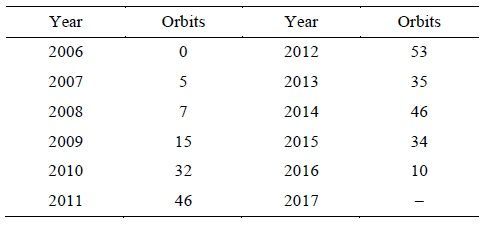
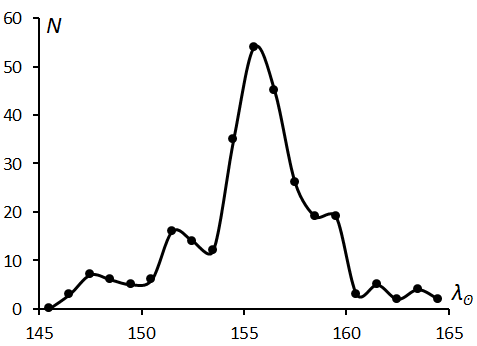
Figure 3 – The number of AGC-523 orbits collected per degree of solar longitude λʘ during the period 2007–2016.
The radiant position, drift and diameter
The radiant was previously reported to be diffuse without any sign of radiant drift (Andreić et al., 2013). Jenniskens et al. (2016) derived a radiant drift based on 15 AGC-523 orbits. The radiant being at a high declination, the spread is rather large in Right Ascension just because of the coordinate system (Figure 4).
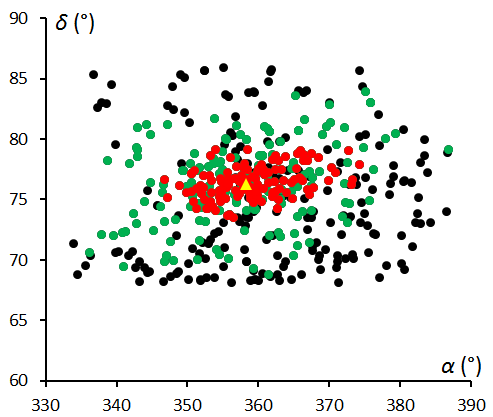
Figure 4 – The radiant positions for all 485 preselected orbits. The black dots failed to fit the similarity criteria. The green dots are orbits that fit the D-criteria with DD < 0.08 and the red dots DD < 0.04. The yellow triangle marks the position of the radiant position of the final reference orbit.
To check for radiant drift we look at the ecliptic coordinates as the radiant is far enough away from the ecliptic pole (Figure 5). Using the ecliptic coordinates for our 283 AGC orbits we find a nice radiant drift of 1.39° in ecliptic longitude λ per degree in solar longitude λʘ and no change in ecliptic latitude β. With other words the radiant moves at ~1.4° per day at β = 63.6° parallel to the ecliptic.
The scatter in Right Ascension is indeed important, but in ecliptic coordinates the radiant drift is very obvious. Figure 6 shows the radiant drift in α (R.A.) against λʘ. The green dots are orbits that fulfill the D-criteria with DD < 0.08 and cover the entire activity period in λʘ between 146° and 165°. The red dots fulfill the high threshold criteria with DD < 0.04 and cover only the inner part of the shower between λʘ 150° to 160°. Figure 7 shows the radiant drift in δ (declination) against λʘ. The scatter in declination is less than in Right Ascension. We consider the inner part with the better similarity scores to derive the radiant drift which results in a radiant drift as: Δα = 1.23° / λʘ and Δδ = 0.47° / λʘ.
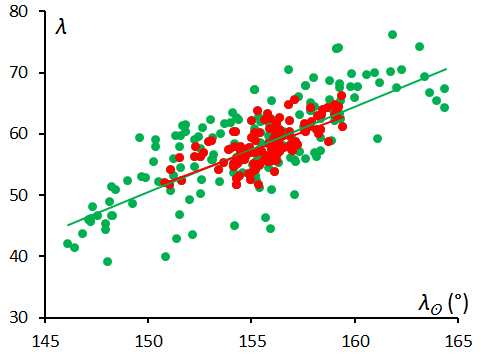
Figure 5 – Radiant drift in ecliptic longitude λ against solar longitude λʘ. The green dots are orbits that fit the D-criteria with DD < 0.08 and the red dots with DD < 0.04.
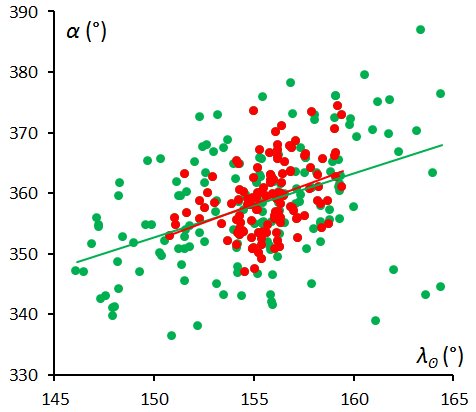
Figure 6 – Radiant drift in Right Ascension α against solar longitude λʘ. The green dots are orbits that fit the D-criteria with DD < 0.08 and the red dots with DD < 0.04.
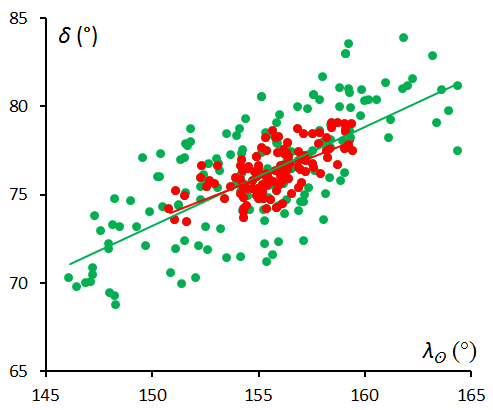
Figure 7 – Radiant drift in declination δ against solar longitude λʘ. The green dots are orbits that fit the D-criteria with DD < 0.08 and the red dots with DD < 0.04.
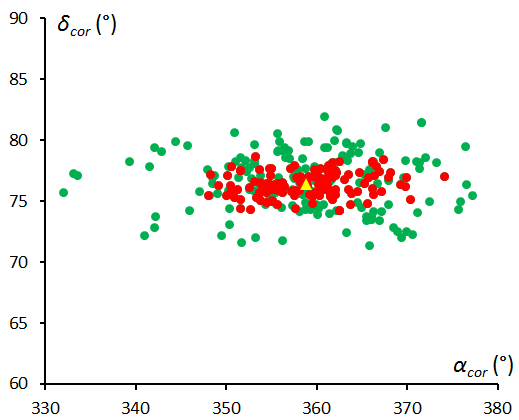
Figure 8 – The radiant drift corrected positions of all 283 radiants in equatorial coordinates. The green dots are orbits that fit the D-criteria with DD < 0.08 and the red dots with DD < 0.04. The yellow triangle marks the position of the radiant position of the final reference orbit.
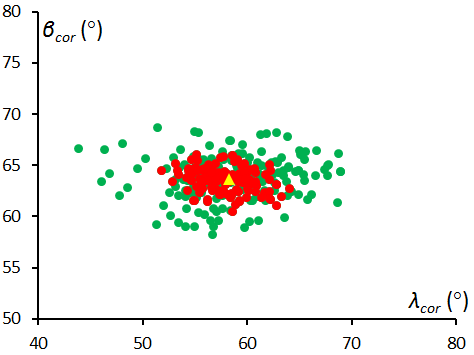
Figure 9 – The radiant drift corrected positions of all 283 radiants in ecliptical coordinates. The green dots are orbits that fit the D-criteria with DD < 0.08 and the red dots with DD < 0.04. The yellow triangle marks the position of the radiant position of the final reference orbit.
To get an idea about the shape and diameter of the radiant we plot the radiants corrected for the daily motion which results in an elongated radiant area with a large spread of over 40° in Right Ascension and about 10° in declination around α = 358.8° and δ = +76.4° (Figure 8). The high declination explains to a large extend the spread in Right Ascension. In ecliptic coordinates the drift corrected radiant positions look more compact with the radiant dispersed parallel to the ecliptic over about three times the dispersion in ecliptic latitude (Figure 9).
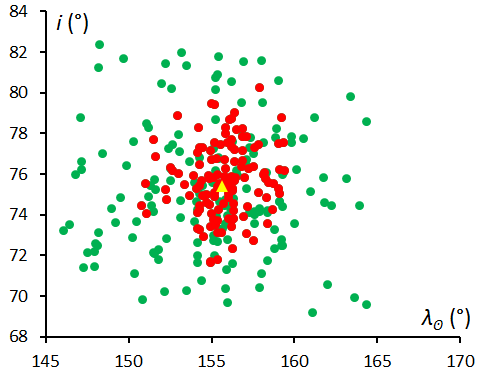
Figure 10 – The distribution of the inclination i in function of the solar longitude. The green dots are orbits that fit the D-criteria with DD < 0.08 and the red dots with DD < 0.04. The yellow triangle marks the position of the final reference orbit.
The dispersed nature of this minor meteor shower is also very well illustrated in the plot of the inclination versus solar longitude (Figure 10). The particles have been smeared out relative to the parent orbit in all directions. The number of bright August gamma Cepheids and the lack of faint meteors is typical for an old meteor stream where most small particles disappeared during the aging process, leaving the larger particles on dispersed orbits. From the available information we can assume that this minor shower is the remnant of an old prograde Halley-type meteor shower.
Other shower characteristics
With a geocentric velocity vg of 43.7 km/s, the AGC-523 are slightly faster than the Southern delta Aquariids with 41.3 km/s (SDA-5) and slightly slower than the April Lyrids with 46.7 km/s (LYR-6). The atmospheric trajectories of the AGC-523 meteors start at 103.4 ± 3.9 km and end at 89.6 ± 5.6 km, heights right in between those for the Southern delta Aquariids and Lyrids (Roggemans, 2017).
7 Conclusion
A search on the orbital data from the major video camera networks worldwide, listing ~635000 orbits available end 2017, resulted in 283 candidate AGC-orbits. 125 orbits fulfill the high threshold D-criteria of DD < 0.04. An analysis of the available orbits proved the presence of a distinct cluster of similar orbits independently from previous stream searches. The resulting reference orbit compares very well with the previously published orbits.
Members of this shower have been detected in each year since 2006 in a time span between 146° and 165° in solar longitude with a maximum at about λʘ = 155.7°. There is no indication for any periodicity in the stream activity. The dispersed nature of this meteor stream together with the abundant proportion of bright meteors and deficiency in faint meteors indicate that this is an old dust stream. Although the radiant is rather diffuse the radiant drift could be calculated.
From this analysis it appears appropriate to consider the August gamma Cepheids (AGC-523) as an established meteor stream.
Table – 2 The orbital data for the August gamma Cepheids (AGC-523) all J2000, the standard deviation σ is listed as ± where available.
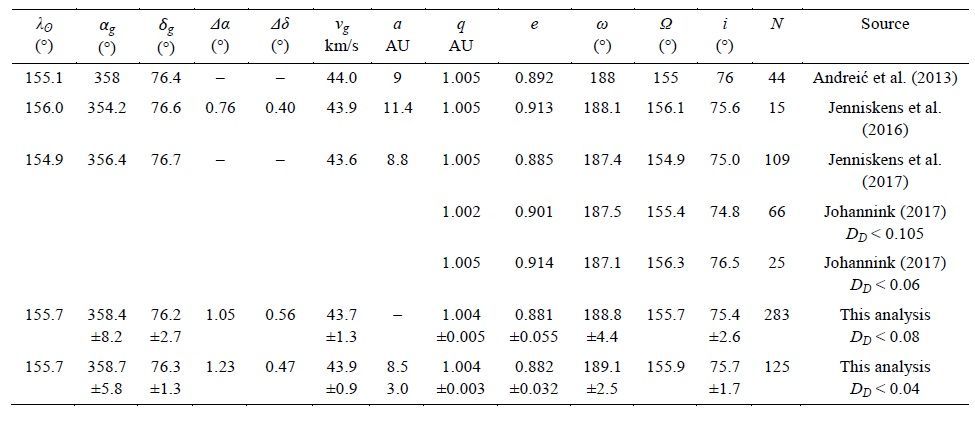
Acknowledgment
The author is very grateful to the network coordinators and their camera operators of the following networks: Croatian Meteor Network (CMN), EDMOND[1][2], SonotaCo Network Simultaneously Observed Meteor Data Sets SNM2007-SNM2016[3], and CAMS. Thanks to Masahiro Koseki for providing the Harvard radar meteor orbit lists. Many thanks to all participants in the CAMS BeNeLux network for their dedicated efforts.
The CAMS BeNeLux team is operated by the following volunteers:
Hans Betlem (Leiden, CAMS 371, 372 and 373), Felix Bettonvil (Utrecht, CAMS 376 and 377) , Jean-Marie Biets (Wilderen, CAMS 380, 381 and 382), Martin Breukers (Hengelo, CAMS 320, 321, 322, 323, 324, 325, 326 and 327), Bart Dessoy (Zoersel, CAMS 397, 398, 804, 805 and 806), Franky Dubois (Langemark, CAMS 386), Luc Gobin (Mechelen, CAMS 390, 391, 807 and 808), Robert Haas (Alphen aan de Rijn, CAMS 360, 361, 362, 363, 364, 365, 367 and 368), Robert Haas / Edwin van Dijk (Burlage, CAMS 801, 802, 821 and 822), Klaas Jobse (Oostkapelle, CAMS 330, 331, 332, 333, 334, 337, 338 and 339) , Carl Johannink (Gronau, CAMS 311, 312, 313, 314, 315, 316, 317 and 318), Hervé Lamy (Dourbes / Ukkel, CAMS 394 and 395/ 393), Koen Miskotte (Ermelo, CAMS 351, 352, 353 and 354), Piet Neels (Ooltgensplaat, CAMS 340, 341, 342, 343, 344 and 345, 349, 840), Tim Polfliet (Gent, CAMS 396), Steve Rau (Zillebeke, CAMS 385 and 387), Paul Roggemans (Mechelen, CAMS 383, 384, 388, 389, 399 and 809), Hans Schremmer (Niederkruechten, CAMS 803) and Erwin van Ballegoij (CAMS 347 and 348).
Their efforts are most important for the achievements of our network.
References
Andreić Z., Šegon D., Korlević K., Novoselnik F., Vida D. and Skokić I. (2013). “Ten possible new showers from the Croatian Meteor Network and SonotaCo datasets”. WGN, Journal of the IMO, 41, 103–108.
Drummond J. D. (1981). “A test of comet and meteor shower associations”. Icarus, 45, 545–553.
Jenniskens P., Gural P. S., Grigsby B., Dynneson L., Koop M. and Holman D. (2011). “CAMS: Cameras for Allsky Meteor Surveillance to validate minor meteor showers”. Icarus, 216, 40–61.
Jenniskens P., Nénon Q., Gural P. S., Albers J., Haberman B., Johnson B., Holman D., Morales R., Grigsby B. J., Samuels D. and Johannink C. (2016). “CAMS confirmation of previously reported meteor showers”. Icarus, 266, 355–370.
Johannink C. (2017). “Augustus gamma Cepheïden: validatie van een onbekende zwerm”. eRadiant, 13, 111–112.
Jopek T. J. (1993). “Remarks on the meteor orbital similarity D-criterion”. Icarus, 106, 603–607.
Kornoš L., Matlovič P., Rudawska R., Tóth J., Hajduková M. Jr., Koukal J., and Piffl R. (2014). “Confirmation and characterization of IAU temporary meteor showers in EDMOND database”. In Jopek T. J., Rietmeijer F. J. M., Watanabe J., Williams I. P., editors, Proceedings of the Meteoroids 2013 Conference, Poznań, Poland, Aug. 26-30, 2013. A.M. University, pages
225–233.
Roggemans P. (2017). “Variation in heights of CAMS meteor trajectories”. eMN, 2, 80–86.
Roggemans P. and Johannink C. (2018). “A search for December alpha Bootids (497)”. eMN, 3.
Šegon D., Andreic Z., Korlevic K., Novoselnik F., Vida D. (2012). “Croatian Meteor Network Catalogue of Orbits for 2007”. WGN, Journal of the International Meteor Organization, 40, 94–97.
SonotaCo (2009). “A meteor shower catalog based on video observations in 2007-2008”. WGN, Journal of the International Meteor Organization,
37, 55–62.
Southworth R. R. and Hawkins G. S. (1963). “Statistics of meteor streams”. Smithson. Contrib. Astrophys., 7, 261–286.
[1] http://meteornews.org/edmond/





